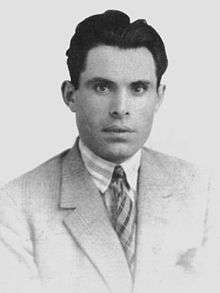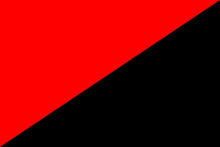Buenaventura Durruti
José Buenaventura Durruti Dumange (14 July 1896 – 20 November 1936) was a Spanish insurrectionary, anarcho-syndicalist militant involved with the CNT, FAI and other anarchist organisations during the period leading up to and including the Spanish Civil War. Durruti played an influential role during the Spanish Revolution and is remembered as a hero in the anarchist movement.
Buenaventura Durruti | |
|---|---|
 | |
| Born | José Buenaventura Durruti Dumange 14 July 1896 |
| Died | 20 November 1936 (aged 40) |
| Occupation | Mechanic |
| Signature | |
| Part of a series on |
| Anarcho-communism |
|---|
 |
|
Concepts
|
|
Organizational forms |
|
Theoretical works
|
|
Biography
Early life
Durruti was born in León, Spain, son of Anastasia Dumange and Santiago Durruti, a railway worker in the yard at León who described himself as a libertarian socialist. Buenaventura was the second of eight brothers (one was killed in the October 1934 uprising in the Asturias, another died fighting the Fascists on the Madrid front).
In 1910, aged 14, Durruti left school to become a trainee mechanic in the railway yard in León. Like his father, he joined the socialist Unión General de Trabajadores (UGT). He took an active part in the strike of August 1917 called by the UGT when the government overturned an agreement between the union and the employers. The government brought in the Spanish Army to suppress the strike; they killed 70 people and injured more than 500 workers. 2,000 of the strikers were imprisoned without trial or legal process. Durruti managed to escape, but had to flee abroad to France where he came into contact with exiled anarchists. The brutality of the Spanish State against anarchism had a profound and lasting effect on the young Durruti. From the autumn of 1917 until the beginning of 1920, Durruti worked in Paris as a mechanic. He then decided to return to Spain and arrived at San Sebastian, Basque Country, just across the border. Here, he was introduced to local anarchists such as Suberviola, Ruiz, Aldabatrecu or Marcelino del Campo, with whom he formed the anarchist paramilitary group Los Justicieros ("The Avengers"). In 1921, during the inauguration of the Great Kursaal in San Sebastian, members of this group attempted unsuccessfully to assassinate King Alfonso XIII. Shortly after Buenasca, the then president of the recently formed anarchist controlled Confederacion Nacional del Trabajo (CNT), persuaded Durruti to go to Barcelona to organise the workers there where the anarchist movement, as well as the syndicalists, was being brutally suppressed and most of its members jailed or executed. Here, with Juan García Oliver, Francisco Ascaso, and other members of Los Justicieros, he founded Los Solidarios ("The Solidarity"). In 1923 the group was also implicated in the assassination of Cardinal Juan Soldevilla y Romero, as a reprisal for the killing of an anarcho-syndicalist union activist Salvador Seguí. After Miguel Primo de Rivera seized power in Spain in 1923, Durruti and his comrades organised attacks on the military barracks in Barcelona and on the border stations near France. These attacks were unsuccessful and quite a few anarchists were killed. Following these defeats, Durruti, Ascaso and Oliver fled to Latin America. They subsequently travelled widely, visiting Cuba and carrying out bank robberies in Chile and Argentina.[1]
Durruti and his companions returned to Spain and Barcelona, becoming an influential militant group within two of the largest anarchist organisations in Spain at the time, the Federación Anarquista Ibérica (FAI), and of the anarcho-syndicalist trade union Confederación Nacional del Trabajo (CNT). The influence Durruti's group gained inside the CNT caused a split, with a reformist faction under Ángel Pestaña leaving in 1931 and subsequently forming the Syndicalist Party.
In the Civil War
Working closely with his comrades in the FAI and CNT Durruti helped to co-ordinate armed resistance to the military rising of the Nationalist faction, an effort which was to prove vital in preventing General Goded's attempt to seize control of Barcelona. During the battle for the Atarazanas Barracks, Durruti's long-time comrade and closest friend Ascaso was shot dead. Less than a week later, on 24 July 1936 Durruti led over 3,000 armed anarchists (later to become known as the Durruti Column) from Barcelona to Zaragoza. After a brief and bloody battle at Caspe (in Aragón), they also halted at Bujaraloz (Video: 'Aguiluchos de la FAI en tierras de Aragon', YouTube) and at 'Venta de santa Lucia', Pina de Ebro, on the advice of a regular army officer, postponing an assault on Zaragoza. The presence of Simone Weil in this region, following the Anarchist columns in this time is known.
Durruti's most famous quote was "We renounce everything except victory" with the undertone that the socialist revolution had to be stopped in advance of the war efforts[2][3]. Buenaventura Durruti's family had roots in Ondarroa, Vizcaya, where they had the pseudonym 'Los Negros', 'The Blacks'. He was shot in Madrid, shortly after being interviewed for USSR TV news.
Death
On 12 November, having been persuaded to leave Aragón by the anarchist leader Federica Montseny on behalf of the government, Durruti led his militia to Madrid to aid in the defence of the city. On 19 November, he was shot while leading a counterattack in the Casa de Campo area (see also Battle of Madrid).
Antony Beevor in The Spanish Civil War (1982) maintains that Durruti was killed when a companion's machine pistol went off by mistake. He assessed that, at the time, the anarchists lied and claimed he had been hit by an enemy sniper's bullet "for reasons of morale and propaganda". The first rumour of his death was that he was shot by his comrades because he enforced discipline.
However, according to anarchist author Abel Paz, Durruti was hit by distant gunfire coming from the area around the Clinical Hospital in the University City, as he laid out in his 1976 book Durruti: The People Armed.[4] Durruti died on 20 November 1936, at the age of 40, in a makeshift operating theatre set up in what was formerly the Ritz Hotel. The bullet was lodged in the heart; the diagnosis recorded was "death caused by pleural haemorrhage". In his later book Durruti in the Spanish Revolution, it was alleged that Durruti was killed by a 9mm bullet to the thorax. The autopsy reported:
"Durruti had a very developed chest. Given the topography of the thorax, I realized that the diagnosis that surgery was impossible had been mistaken. An operation could have produced positive results, although doubtlessly the patient would not have survived."[5]
He is buried in the Montjuïc Cemetery, Barcelona,[6] after receiving a hero's funeral.[7]
A few hours after Durruti's death, the CNT-FAI troops massacred 52 policemen, who had been held captive in a monastery in Calle de Santa Engracia, in reprisal.[8]
Legacy
It is we [the workers] who built these palaces and cities, here in Spain and in America and everywhere. We, the workers. We can build others to take their place. And better ones! We are not in the least afraid of ruins. We are going to inherit the earth. There is not the slightest doubt about that. The bourgeoisie might blast and ruin its own world before it leaves the stage of history. We carry a new world here, in our hearts. [...] That world is growing in this minute.
— Buenaventura Durruti[9]
At first, Durruti's death was not made public, for morale reasons. Durruti's body was transported across the country to Barcelona for his funeral. Over a half million people filled the streets to accompany the cortege during its route to the Montjuïc Cemetery. It was the last large-scale public demonstration of anarchist strength of numbers during the Spanish Civil War.
Hugh Thomas remark, "the death of Durruti marked the end of the classic age of Spanish anarchism. An anarchist poet proclaimed that Durruti’s nobility while living would cause ‘a legion of Durrutis’ to spring up behind him".[10]
In 1937, as a response to the further participation of the CNT-FAI in the Republican government, and after the May Days in 1937 in Barcelona, the Friends of Durruti Group was founded, to try and save the anarchist principles of the revolution. The name of Durruti clearly taken because of the revolutionary commitment and the symbol that he still was for that in the anarchist camp. The Friends of Durruti group had a newspaper called El Amigo del Pueblo (The Friend of the People) and tried to make revolutionary propaganda among the rank and file of the CNT. The group was however fiercely repressed by the reformist wing of the CNT, in collaboration with the Republican government.
The name of the English post-punk band The Durutti Column was derived from a misspelling of the Durruti Column, Durruti's anarchist military unit in the Spanish Civil War.
Willem van Spronsen, an anarchist who was killed while trying to disable a fleet of buses operated by U.S. Immigration and Customs Enforcement (ICE) for mass deportation, used Durruti's surname as a part of his alias.[11][12]
Gallery
 Funeral of Durruti, Barcelona, 23 November 1936
Funeral of Durruti, Barcelona, 23 November 1936 Durruti's grave full of flowers on the 69th anniversary of his death
Durruti's grave full of flowers on the 69th anniversary of his death- Durruti's grave at Montjuïc Cemetery, Barcelona
- "Hálito Durruti", monument to Buenaventura Durruti in his hometown of León
See also
- Anarchism in Spain
- Anarchist Catalonia
- The Durutti Column, a post-punk band whose name derives from Durruti
Notes
- Paz, Abel (2007). Durruti in the Spanish Revolution. Oakland: AK. ISBN 1-904859-50-X.
- Revolution and War in Spain, 1931-1939, Paul Preston page 235
- The Spanish Republic at War 1936-1939, Helen Graham page 179
- Abel Paz Durruti: The People Armed AK Press, 2006. ISBN 978-1-904859-50-5. Translated by Chuck W. Morse
- Paz, Abel (1976). Durruti in the Spanish Revolution. AK Press. p. 600.
- "Durruti, Buenaventura, 1896-1936". libcom.org. Retrieved 15 January 2020.
- Casanova 2005, p. 251.
- Ruiz, Julius (2014). The 'Red Terror' and the Spanish Civil War. Cambridge University Press. p. 284. ISBN 9781107054547.
- Van Paasen, Pierre (18 August 1936). "Durruti Dumange, José Buenaventura: 2 000 000 anarchists fight for revolution says Spanish leader". The Toronto Daily Star. pp. 1, 5. (note: interview made on 5 August 1936).
- Thomas, The Spanish Civil War 416
- Cleary, Tom (14 July 2019). "Willem Van Spronsen aka Emma Durutti: 5 Fast Facts You Need to Know". Heavy.com. Retrieved 22 December 2019.
- Collective, CrimethInc Ex-Workers. "CrimethInc. : On Willem Van Spronsen's Action against the Northwest Detention Center in Tacoma : Including the Full Text of His Final Statement". CrimethInc. Retrieved 22 December 2019.
References
- Emma Goldman Durruti is Dead, Yet Living (1936).
- Hugh Thomas The Spanish Civil War. Middlesex, England: Penguin Books Ltd., 1965.
- Hans Magnus Enzensberger The Short Summer of Anarchy: Life and Death of Buenaventura Durruti (1972) (originally: Der kurze Sommer der Anarchie: Buenaventura Durrutis Leben und Tod).
- Antony Beevor The Spanish Civil War (1982).
- Gabriel Garcia Marquez María dos Prazeres in Doce cuentos peregrinos (1991).
- Collective work Buenaventura Durruti, a double CD nato, (1996).
- Pedro de Paz The Man Who Killed Durruti Read and Noir (2005).
- Abel Paz Durruti in the Spanish Revolution, Translated by Chuck W. Morse, AK Press, 2007. ISBN 1-904859-50-X.
Further reading
- Lane, A. T. (1995). Biographical Dictionary of European Labor Leaders. Greenwood Publishing Group. ISBN 978-0-313-26456-6.
External links
| Wikimedia Commons has media related to Buenaventura Durruti. |
| Wikiquote has quotations related to: Buenaventura Durruti |
- Buenaventura Durruti in the Spanish Revolution. Biopic by Paco Rios based on the book by Abel Paz
- Biography of Buenaventura Durruti at libcom.org history.
- Buenaventura Durruti at the Anarchist Encyclopedia.
- The first days of the Spanish Revolution, Durruti & the Durruti column... (often misspelled as Durutti) at The Daily Bleed.
- Website about Buenaventura Durruti
- Return of the Durruti Column Situationist Cartoon strip

